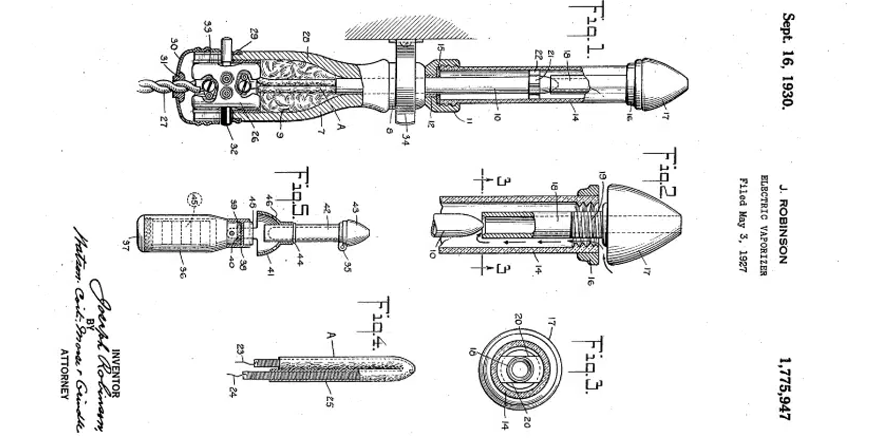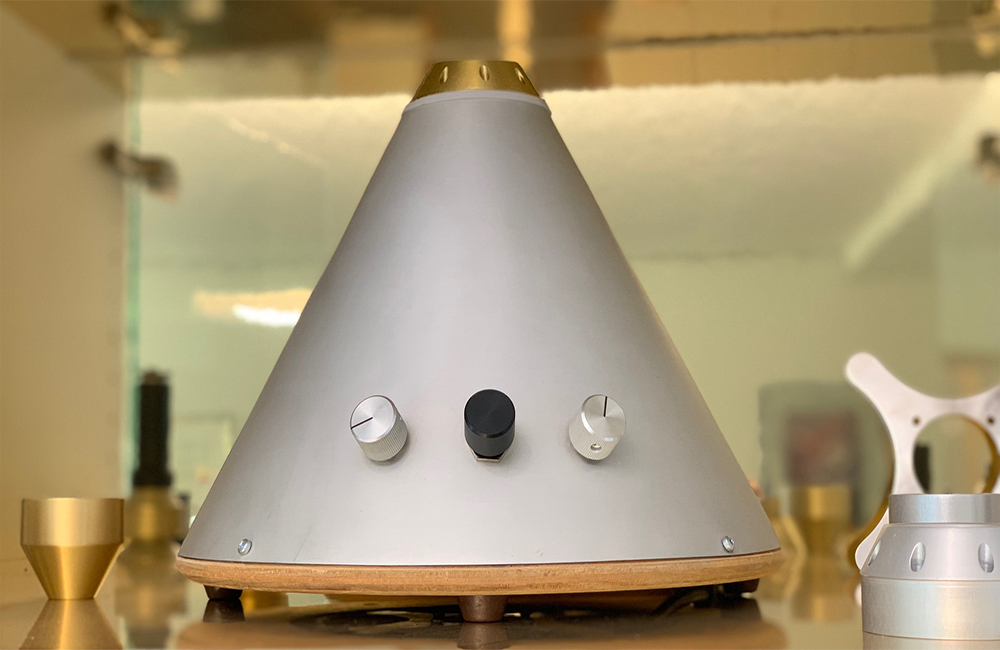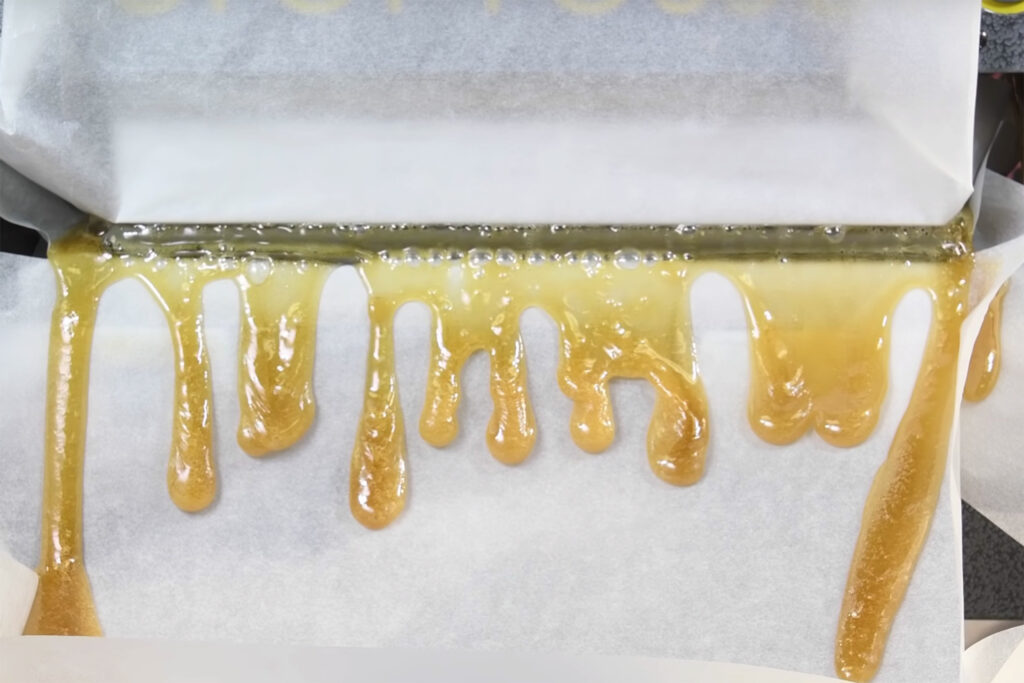Introduction
Vaping has transformed from a niche interest into a mainstream phenomenon, capturing the attention of technology enthusiasts and health-conscious individuals alike. Whether it’s e-cigarettes, dry herb vapes, or dry herb vaporisers, the multitude of devices available today speaks to the rapid evolution of vaping technology.
This blog explores the journey of vaping from its early beginnings to the advanced devices we see today. While vaporising herbal material is nothing new, the way it’s been adapted specifically for dry herb and concentrates is relatively recent.
Vaping: Humble Beginnings

The roots of modern dry herb vaporisers trace back to the early 20th century. In 1927, Joseph Robinson made a significant breakthrough by patenting a mechanical butane ignition vaporiser. This marked the earliest documented vaporiser form in the United States. The product was never really commercialised and it isn’t even clear if a prototype for this primitive vape was ever manufactured.
It was one Herbert Gilbert, a scrap metal dealer and Korean War veteran, who in 1960, patented an invention that more closely resembles today’s vaporisers. Gilbert’s device, dubbed the “Smokeless”, produced flavoured steam without nicotine. Gilbert’s invention was ahead of its time, received little attention and was never commercialised because smoking was still fashionable. Gilbert’s invention laid the groundwork for future developments in vaping technology and has been frequently cited by modern inventors. Gilbert expresses pride in his role in paving the way for devices that offer safer and healthier alternatives to smoking.
Vaping Devices Starting to Take Shape
The dry herb community’s engagement with vaporisers took a more defined shape in 1989. “High Times,” a magazine known for advocating the legalisation of marijuana, published a pivotal article by Dr. Lunglife. This piece provided instructions for creating a low-cost vaporiser from readily available parts, along with methods for producing a potent dry herb concentrate. The design cleverly used a lightbulb thread as the heating element.
A significant advancement came in 1993 from Eagle Bill, a Native American medicine man, who invented the “Shake & Vape.” This device was a simple glass pipe with a chamber for herbs, heated from below with a lighter to produce vapour. Eagle Bill showcased the Shake & Vape at the 7th Dry Herb Cup in Amsterdam, where it became an instant sensation, dominating popularity at the event for a decade and significantly boosting the adoption of vaping within the dry herb community.
The Vaping Volcano

The dry herb vaping technological evolution has been marked by significant inventions and advancements since the late 20th century. One of the earliest notable devices is the Volcano, a tabletop vaporiser developed in 1996 by German entrepreneur Markus Storz. The Volcano, which entered the United States market in 2003, was acclaimed for its ability to produce powerful vapours from dry herb. Despite its high cost, the device set a benchmark for quality and efficiency in vaporisation technology.
At the same time that devices like the Volcano were being developed, the dry herb industry saw significant advancements in the use of dry herb extracts. Historically, a niche segment of users extracted THC through rudimentary methods involving alcohol, known informally as “hash oil.”
Dry Herb Exctracts

However, modern techniques refined this process by using solvents like ethanol or butane to extract THC from dry herb leaves. This method not only allowed for the utilisation of the entire plant, including stems and other previously discarded parts, thereby increasing efficiency but also led to the production of highly concentrated dry herb oil. These oils could be enhanced with flavourings and other additives to improve taste and vapour production.
Hon Lik Changes the Vaping Game

The innovations in dry herb oil extraction significantly boosted the popularity of portable vaporisers. This trend culminated in 2003 with the invention of the modern electronic cigarette vaporiser pen by Chinese pharmacist Hon Lik. His device, which featured a battery, a cartridge for the solution or concentrate, and an atomiser, laid the groundwork for the first vape pens to enter the US market in 2007. These pens became an instant success, sparking a wave of new designs tailored specifically for dry herb and cannabinoid products.
While many innovators contributed to the development of vaporising methods, it’s fair to say that Hon Lik played a crucial role in the explosion of vaping products we see beginning around that time. His invention coincided with increasing anti-smoking sentiment and stricter regulations on smoking in public places. This societal shift towards smoking cessation created a fertile ground for the adoption of vaping as an alternative, just as Hon Lik’s device was being commercialised.
Societal Changes that Affected Vaping
The transition from Hon Lik’s groundbreaking invention of the e-cigarette to the sophisticated dry herb vaporisers of today has been marked by significant technological and cultural shifts. After Hon Lik commercialised the modern e-cigarette in the early 2000s, the technology quickly adapted to a burgeoning market looking for smoke-free alternatives. This amidst growing health consciousness and stricter public smoking bans.
The demand for e-cigarettes has grown year after year, alongside increasing restrictions and regulations in the tobacco industry. Nowadays, it’s rare to find young people (teenagers) smoking with the same frequency and prevalence as past generations. E-cigarettes and vapes have also improved their marketing. Exciting flavours, modifications to enhance the clouds produced by vaporisers, and popularising vaping tricks were introduced.
But it’s not just e-cigarettes that are gaining popularity. As vaping technology gained acceptance, innovators within the dry herb industry saw an opportunity to apply these advances to marijuana consumption. This led to the development of devices specifically designed for dry herb. They even began to incorporate the same level of technological sophistication as mainstream electronics.
Dry herb vapes and dry herb vapes also saw a surge in demand, partly because they have become more compact and affordable. Bulky machinery is no longer necessary for great vaping sessions; portable and pen-type vapes now offer fantastic user experiences.
Medicinal Marjiuana and Vaping

Furthermore, dry herb is increasingly accepted as a form of medication for various ailments. Doctors, who are generally reluctant to prescribe smoking in the form of joints or cones, often recommend vaporisers instead. This has brought a significant new demographic into the market, driving up demand for vaporisers within medicinal and recreational communities.
Modern Day Vaping
In recent years, the dry herb vaporizer industry has become increasingly intertwined with the tech sector, particularly in Silicon Valley. Mark Williams, a co-founder of a prominent dry herb vape brand, brought his expertise from a prior role as a product developer at Apple. Similarly, PAX Labs, known for its innovative weed vaporisers, originated as a tech startup in San Francisco.
The aesthetic and functionality of dry herb dispensaries and vaporising devices have evolved to mirror consumer electronics. Many dispensaries are adopting a minimalist, Apple-store-like design. Modern vaping devices now often resemble USB drives or other smart devices. Many feature sleek designs enhanced by advanced technologies such as LED displays and Bluetooth connectivity for app synchronisation. The variety in design and quality of vaporisers is broader than ever, catering to a wide range of preferences and needs.
Industry trends are increasingly moving towards the use of disposable pre-filled cartridges containing dry herb extracts or oils. These cartridges offer convenience, ease of use, and a cleaner, more controlled dosing option, aligning with consumer preferences for devices that are both user-friendly and perceived as more medicinal.
However, the widespread adoption of such models might be some way off in more restrictive countries, including New Zealand. There remains a cloud of uncertainty over the legalisation of dry herb and the potential establishment of a dispensary model similar to that in the USA.
The Leading Vaping Brands Driving Development
The dry herb vaping sector continues to invest heavily in research and development. Companies like CILICON, Pax Labs, Storz & Bickel are at the forefront, striving to enhance the safety, convenience, and enjoyment of vaping. Xmax, Fenix and Airvape all offer their own contributions to the development of these technologies.
Fenix are known for their innovative convection technologies and offer their users an amazing experience while still managing to keep their prices out of the top tier range. XMax produces some outstanding compact vaporisers that keep up with the big players with no issues at all.
The Future of Vaping
The continuous advancements and the increasing integration of high technology in vaporisers signal a promising future for the dry herb vaping industry. As research and development propel forward, consumers can expect even more sophisticated vaping devices. These will not only focus on health and safety but also enhance the overall user experience. This includes improvements in battery life, heating elements, and smarter features like app-based controls which make precision dosing and temperature control more accessible to everyday users.
Moreover, the increasing legal acceptance of dry herb is likely to drive further growth in the vaping industry. As countries continue to relax dry herb laws and acknowledge its medicinal benefits, the market for dry herb vaporisers is expected to expand. New opportunities for innovation and business will develop as a result.
However, the path forward is not without challenges. Regulatory frameworks will play a critical role in shaping the industry, influencing everything from product design to marketing strategies. Manufacturers and consumers will both need to navigate these regulations carefully. Complying while continuing to advocate for reasonable policies that facilitate responsible use and technological advancement.
Conclusion
The evolution of vaping from a niche to a mainstream product speaks to both technological innovation and changing societal attitudes towards dry herb. As we move forward, it is clear that the synergy between technology and user-centric design will continue to drive the market. Safer and more effective alternatives to traditional smoking methods will become available as a result. Companies like CILICON, Pax Labs, Storz & Bickel, along with Fenix, XMax, and AirVape, are not just participants but pioneers in this dynamic field. Each contribute to a future where vaping is not only a part of dry herb culture, but also a key element of wellness lifestyles around the globe.


